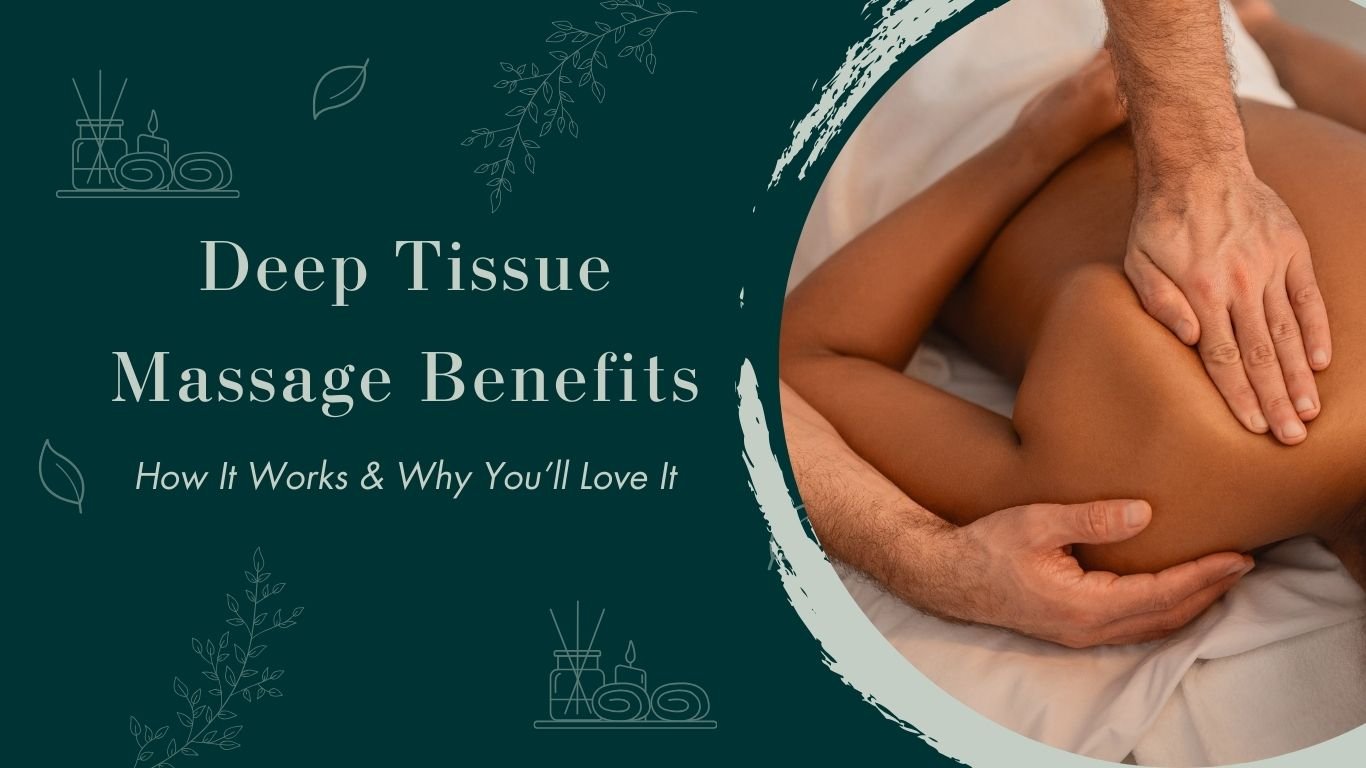What Is a Deep Tissue Massage: A Guide to Chronic Tension Relief
How heavy does it feel when your muscles are strained to the breaking point? You may find relief with deep tissue therapy. But what is a deep tissue massage, and why is it so effective for stress, pain, and recovery?
At Healing Forest Massage, our deep tissue massage techniques specifically target the deeper layers of muscle to relieve tension and eliminate knots. By applying firm, sustained pressure where you feel the most strain, we help improve circulation, ease discomfort, and restore mobility.
Let’s explore the effects of deep tissue massage, how it works, and why it may be the right choice for you.
What is a Deep Tissue Massage?
A deep tissue body massage is a therapeutic technique that uses slow, controlled strokes and firm pressure to reach the deeper muscle layers and fascia (the connective tissue around muscles).
One key difference in the Swedish vs deep tissue massage comparison is the depth and intensity of the techniques used. While Swedish massage focuses on the outer muscle layers using gentle, flowing strokes to promote relaxation, deep tissue massage targets the deeper layers of muscles and fascia. A deep tissue massage therapist may use knuckles, fists, elbows, or specialized tools to apply firm pressure and address chronic tension
If you’ve ever wondered, “what is a deep tissue full body massage?” it’s a more comprehensive version of this approach, working across all major muscle groups to deliver total-body relief.
Why Choose Deep Tissue Massage for Chronic Tension Relief?
Chronic tension may be defined as, “A condition of muscle rigidity or stiffening that persists for an extended period.” Unlike acute tension, which may develop as a result of a specific activity or injury and resolve rapidly, chronic tension is a more enduring condition.
The Effectiveness of Deep Tissue Massage
Due to its targeted therapeutic approach, deep tissue massage has helped relieve chronic tension and treat fibromyalgia and sports injuries:
Symptoms of fibromyalgia include extensive musculoskeletal pain and touch sensitivity. Deep tissue massage relieves muscular tension and improves range of motion. It may also reduce this condition's discomfort, improving quality of life.
Advantages of Deep Tissue Massage
Targets Deeper Muscle Layers
Improved Range of Motion
Enhanced Circulation
Break Down Scar Tissue
Posture Correction
Stress Reduction
For particularly stubborn adhesions, your therapist may recommend incorporating Cupping Therapy to enhance the effects of your deep tissue massage.
What are the Benefits of Deep Tissue Massage?
The deep tissue massage benefits extend beyond relaxation. Studies show it can support both physical and psychological health.
Physical Benefits of Deep Tissue Massage
Pain Relief: A 2014 study in Pain Medicine showed deep tissue massage equally helpful as NSAIDs in relieving persistent low back pain. The research reveals that deep tissue massage may help manage discomfort without medication.
Improved Blood Circulation: The focused pressure and friction techniques used in deep tissue massage can stimulate blood flow throughout the body. A 2014 Science Daily article explored the effects of massage on circulation and concluded that massage therapy can increase blood flow, and help in muscle recovery.
Enhanced Range of Motion: Muscle tightness, when it's chronic, may greatly limit mobility. Both static stretching and deep tissue massage improved flexibility and reduced discomfort, according to a 2022 Research Gate study.
Reduced Muscle Soreness: Deep tissue massage has been shown to reduce muscular fatigue and discomfort after exercise. The impact of massage on DOMS was examined in a 2020 review published in Frontiers in Physiology. Although the analysis found some evidence that massage treatment could help with muscular pain, it also stressed the importance of doing more high-quality studies to confirm these claims.
Psychological Benefits of Deep Tissue Massage
Stress Reduction: To deepen the stress-reducing effects, consider complementing your treatment with one of our Sound Bath sessions. An International Journal of Behavioural Medicine research from 2022 examined how massage treatment affects stress and anxiety in healthcare practitioners. Massage treatment decreased tension and anxiety compared to a control group.
Improved Mood: Deep tissue massage helps relax the body and improve mood. A 2020 study published in Complementary Therapies in Medicine examined the effects of massage therapy on mood and depression symptoms, showing that treatment by a skilled deep tissue massage therapist can reduce feelings of sadness and enhance emotional well-being.
Enhanced Sleep Quality: Chronic pain and stress drastically affect sleep. Massage therapy's impacts on sleep quality in different demographics were examined in a 2023 Journal of Clinical Medicine study. The analysis found that massage treatment may enhance sleep for chronic pain and insomniacs.
How Does Deep Tissue Massage Work?
Wondering “how does deep tissue massage work?” It’s all about depth and precision. The therapist uses slow, concentrated strokes to reach underlying muscle fibers and fascia. This breaks up adhesions (“knots”), reduces stiffness, and restores blood flow.
Some people ask, “is a deep tissue massage painful?” It may feel intense or uncomfortable at times, but it should never feel harmful. Most describe it as a “good pain” that leads to relief.
What are Deep Tissue Massage Techniques?
Professional therapists use a variety of massage therapeutic techniques, including deep tissue methods such as:
Slow Strokes – To gradually reach deeper muscle layers.
Deep Finger Pressure – Using knuckles, elbows, or fists for firm, sustained contact.
Striping – Long, gliding strokes across muscle fibers.
Trigger Point Therapy – Targeting “knots” that refer pain elsewhere.
Cross-Fiber Friction – Breaking adhesions by working across the muscle grain.
Petrissage & Kneading – To improve circulation and flexibility.
Static Pressure – Sustained contact to release deep-seated tension.
These are the core deep massage therapy techniques you’ll experience during a session.
What to Expect During and After a Deep Tissue Massage?
During the Session: Expect firm, steady pressure. You may feel some intensity as the therapist works through tight spots, but always communicate your comfort level.
After the Session: Mild soreness is common, similar to post-workout aches. Drink water to flush out toxins and support recovery.
If you’re curious about “how to do deep tissue massage at home” — professional training is essential for safety and effectiveness. Instead, consider tools like a good deep tissue massager for self-care between sessions.
What are the Aftercare Deep Massage Therapy Tips?
Before your massage:
Stay hydrated.
Eat a light meal 1–2 hours prior.
Arrive early to relax and discuss any concerns with your therapist.
After your massage:
Drink water to aid recovery.
Rest and avoid intense exercise for 24–48 hours.
Eat nutrient-rich foods to support muscle repair.
Take time to relax and let your body absorb the benefits.
Swedish vs. Deep Tissue Massage
Many clients ask: “What’s the difference between Swedish and deep tissue massage?”
Swedish massage: Gentle, flowing strokes designed for relaxation.
Deep tissue massage: Firm, targeted pressure designed to release chronic tension and knots.
Both are beneficial, but for persistent pain or tightness, deep tissue therapy is the better choice.
Conclusion
A deep tissue massage is more than just pressure, it’s a science-backed therapy that targets deeper muscle layers to relieve tension, reduce pain, improve flexibility, and support mental well-being.
If you’ve been wondering “deep tissue massage, what is it, and is it good for you?”, the answer is clear: yes, when performed by a trained therapist, it’s one of the most effective massage techniques including deep tissue for long-lasting relief.
Book your session at Healing Forest Massage today and experience the restorative deep tissue massage benefits for yourself.
FAQs:
Q: How do you give a deep tissue massage?
Deep tissue requires slow strokes, firm pressure, and advanced anatomical knowledge. Only trained therapists should perform it safely.
Q: What is a good deep tissue massager?
Percussion massagers and foam rollers can provide relief between sessions, but they are not a replacement for a professional therapist.
Q: What is a deep tissue full body massage?
It’s a complete session that works on all major muscle groups for overall tension release, stress relief, and better circulation.
Q: What is a deep tissue back massage?
This focuses specifically on back muscles, making it one of the most requested treatments for posture-related pain and stiffness.
Q: How should I prepare for a deep tissue massage at Healing Forest?
Hydrate, eat a light meal, arrive early, and communicate your needs with your therapist.
Q: After a deep tissue massage, what should I do?
Rest, hydrate, and avoid heavy exercise for 24–48 hours to allow full recovery.


